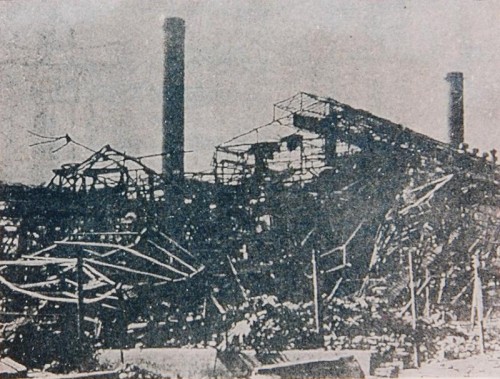TELDAP Collections
| A Sweet Story—The History of Taiwan’s Sugar Industry |
|
Just how much do we crave sugar? The Ghost Month, a short story in Volume VII of Creative Comic Collection, tells a story about a human spirit who is so obsessed with nougat that after his body has deceased, he still wanders about in the human world, searching for the sweetness in his memory…and he finds it in a sugar factory!
Cane sugar once played a vital role in Taiwan’s economic miracle in the twentieth century, but its production began much earlier. In fact, the earliest use of the sugarcane mill dates back to the late Ming Dynasty, in roughly the seventeenth century. Sugarcane is a non-native crop that had adapted well to southern Taiwan’s climate and soil. When Taiwan was under Dutch rule during the seventeenth century, sugarcane was used to make sugar, which was sold to Japan. During the time that Koxinga, a Ming Chinese military leader, governed Taiwan, the trade of sugar brought much wealth to the island, which resulted in the following saying in Fujian and Guangdong, the two Chinese provinces close to the island: “Taiwan has so much money it floods your ankles.” This reputation also showed Taiwan’s great appeal to potential immigrants. In 1861, the Treaty of Tianjin, which had been signed by the Qing empire and other countries, entered into effect. The Treaty opened Taiwan for trade, and thus camphor, sucrose, and tea leaves became Taiwan’s major export items. During the Japanese occupation of Taiwan, a dozen sugar companies were founded on the island, including Dai-Nippon, Taiwan, Meiji, Ensuiko, Shinko, and Teikoku. At its peak, the number of sugar factories on the island reached forty-two, and Taiwan’s sugar production ranked only after India, Cuba, and Java in quantity. In fact, in an exposition organized to celebrate the forty years of Japanese rule in 1935, the sugar industry exhibit reminded visitors, “The sugar industry is the mother of Taiwan’s culture.”
 Locations of Sugar Companies and Their Factories in Taiwan (1939)
In the prime of the sugar industry, sugarcane railroads totaling 3,000 kilometers transported supplies to sugar factories all over the island, and Taiwan was called the “Kingdom of the Sugar Rail.” The by-products of the sugar production process (extraction, boiling, and crystallization) such as wet bagasse and molasses were turned into fuel, paper, organic fertilizer, or ethanol. In fact, ethanol from these facilities served as a very important military supply.
During World War II, however, ethanol-producing venues were attacked by U.S. troops as military facilities. Many sugar factories were bombed, resulting in serious damage and severe casualties; certain facilities were only rebuilt due to Taiwan Sugar Corporation’s (TSC) effort. In 1952, new varieties of sugarcane were introduced, which pushed production back to the pre-war level. In 1975, cane sugar production contributed to record export proceeds of NT$5.1 billion. Starting from the next year, however, international sugar prices dropped continuously. Eventually, the financial loss in exports resulted in TSC’s layoff and closing down of its sugar factories.
Huwei Sugar Factory was heavily bombarded and severely damaged during World War II. (Picture credit: Sugar Industry Cultural Digital Archives: Memoires of the Sugar Industry)
In the aftermath of war, TSC managed to rebuild sugar factories. (Picture credit: Sugar Industry Cultural Digital Archives: Memoires of the Sugar Industry)
Now TSC is a multi-services corporation and operates across different industries such as quality agriculture (e.g. the Moth Orchid), animal husbandry, bio-technology, logistics, land development, and tourism. In its efforts to promote tourism, TSC taps into its hundred years’ legacy in the sugar industry. For instance, the first modern sugar factory in Taiwan—Qiaotou Sugar Factory (a.k.a. the Kaohsiung Branch of TSC)—has been turned into the Taiwan Sugar Museum. The venue exhibits sugar production facilities, agricultural implements and machinery, and railroad scenes. The process of sugar production is also in display. Visitors will find in this museum a mix of Japanese and Baroque architecture, wonders of ecological diversity, and the glories of Taiwan’s sugar industry. Why not come to this historical monument, travel to the past, and embrace these old-time memories?
A train carrying sugarcane for processing—a typical Taiwan scene during the Japanese occupation.
Picture credit: Sugar Industry Cultural Digital Archives: Memoires of the Sugar Industry)
References:
Yang Yanqi (2001). Story of Taiwan Cane Sugar. Taipei: Fruition.
Chen Mingyan (2007). Sugar Industry in Taiwan. Taipei County: Walkers.
Xie Lingyu (2002). The Old Days of Xinying Sugar Factory. Tainan County: Xinying District Office.
Ito Shigero (1939). History of the Taiwan Sugar Refining Company. Tokyo: Taiwan Seito K. K. Tokyo Shutchojo.
Cultural Association of Taiwan Sugar Industry (2005). The Illustrated History of Meiji Sugar Co., Ltd. Taipei: Taiwan Takechi Sugar Foundation
Cultural Association of Taiwan Sugar Industry (2005). The Illustrated History of Ensuiko Sugar Co., Ltd. Taipei: Taiwan Takechi Sugar Foundation
|















